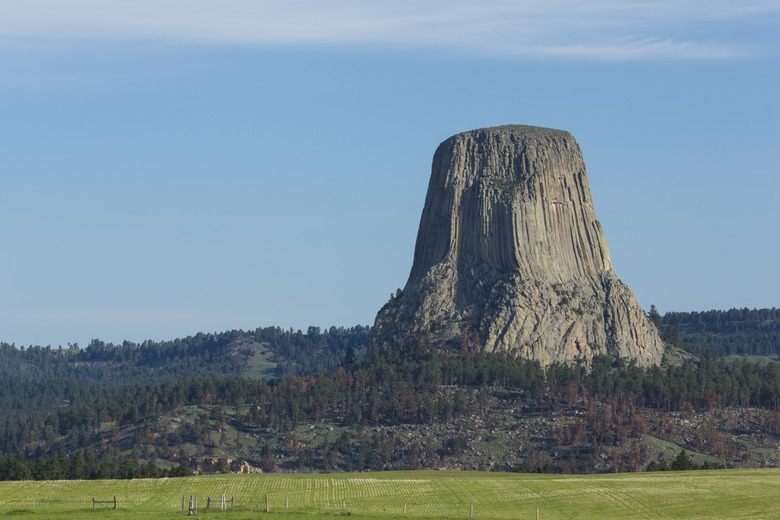How Was Devils Tower Formed?
The Kiowa and Cheyenne say an outsized grizzly bear raked the spire of northeastern Wyoming's Devils Tower — Tree Rock to the Kiowa, the Bear's Lodge to the Cheyenne — while people huddled on top. It's a more vivid origin story than the ones geologists propose, which nonetheless has the drama of molten rock and deep time.
Devils Tower as Igneous Intrusion
Devils Tower as Igneous Intrusion
Many scientists suspect Devils Tower represents a fist of magma, or molten rock, that "intruded" overlying sedimentary layers but didn't attain the surface: either a laccolith or a stock. The sedimentary deposits, which include sandstone, shale and beds of gypsum, were laid down in the Mesozoic era, when the region often lay drowned under inland seaways. The Devils Tower magma billowed up 50 million to 60 million years ago, coinciding with the uplift of the Black Hills.
Forming the Tower
Forming the Tower
The underground magma cooled into phonolite porphyry, an igneous rock, fracturing as it did so to form the iconic hexagonal columns of today's pillar. Subsequent erosion has removed the sedimentary strata once surrounding the intrusion, which — tougher in consistency — better resisted the gnawing force of water. Stolid as Devils Tower looks, it's nevertheless being dismantled by erosion and weathering, as the rubble at its base reveals.
Alternate Theories
Alternate Theories
Not all geologists have agreed that the seed magma of Devils Tower formed as a laccolith or stock. Earlier theories represented the butte as the neck of a mostly demolished volcano. A paper presented at a 2011 session of the American Geophysical Union, meanwhile, proposed the tower might be the ruins of a crater-pooled lava lake.
References
- National Park Service: Devils Tower National Monument — How Is Devils Tower a Sacred Site to American Indians?
- National Park Service: Devils Tower National Monument — Places
- National Park Service: Devils Tower National Monument — Geologic Formations
- The Changing Earth: ExploringGeology and Evolution; James Monroe, Reed Wicander
- U.S. Department of the Interior: Geological Survey Bulletin — Geology of Devils Tower National Monument, Wyoming
- American Geophysical Union: Fall Meeting 2011 Abstract — On the Geological Origin of Devils Tower (WY, USA)
Cite This Article
MLA
Shaw, Ethan. "How Was Devils Tower Formed?" sciencing.com, https://www.sciencing.com/devils-tower-formed-5166713/. 24 April 2017.
APA
Shaw, Ethan. (2017, April 24). How Was Devils Tower Formed?. sciencing.com. Retrieved from https://www.sciencing.com/devils-tower-formed-5166713/
Chicago
Shaw, Ethan. How Was Devils Tower Formed? last modified March 24, 2022. https://www.sciencing.com/devils-tower-formed-5166713/
